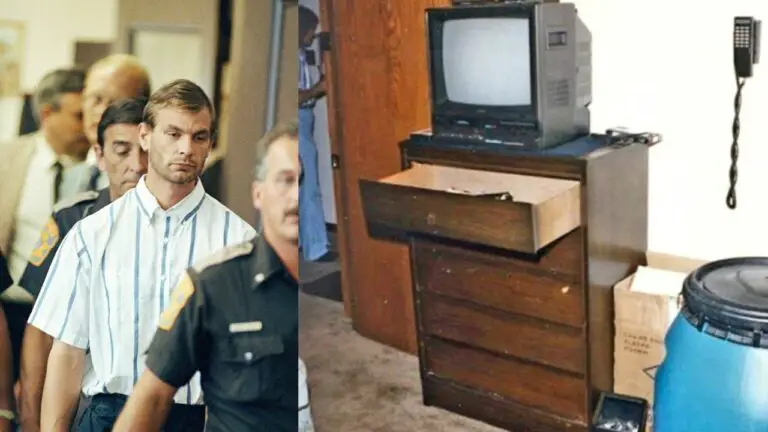Jeffrey Dahmer was immediately arrested as soon as the police found more than 84 polaroid pictures of his victims inside his dresser drawer. Crime mag had published the graphic look inside his closet as well. However, it is unavailable right now because the original photographs were too disturbing and some people got mentally affected by them. Follow to know what happened to his dresser drawer and other belongings.
Monster: The Jeffrey Dahmer Story, a Netflix original series, examines the brutal and gruesome murder committed by known serial killer Jeffrey Dahmer. When Jeffrey was arrested, the authorities discovered skulls, human torsos, and other pieces of his victims' remains in his possession. Between 1978 and 1991, he killed 17 men and boys in all. Authorities also learned that he was constructing a macabre shrine out of the skulls of the victims he had killed.
Thousands of people have already watched the Netflix series, and many have been left in wonder by some of its sequences. We are reflecting on what happened to his apartment and all the furniture in it as the series explores some of the most horrifying atrocities perpetrated by the serial killer.
Similarly, we also now know that Jeffrey Dahmer was arrested as soon as the police looked at his dresser drawer, just like in the show. And many people have been wanting to know what people really saw inside the dresser drawer and what happened to it after his arrest. Well, let's find it out.
Jeffrey Dahmer’s Dresser Drawer: The Police Found More Than 84 Polaroid Pictures of His Victims in the Closet; A Graphic Look Inside His Drawer; Crime Mag & Original Photographs!
Jeffrey Dahmer's dresser drawer was full of countless polaroid photos of the victims stashed away. The original pictures/photographs were so brutal that it was not made public. True Crime Magazine had published the graphic look inside his dresser drawer. However, it has been made unavailable right now. Maybe the pics were very disturbing and might have affected some people's mental health.
In July 1991, Tracy Edwards, the intended victim of Dahmer, escaped away from his apartment and called the police. This would prove to be the serial killer's downfall. Two Milwaukee police officers followed Edwards back to Dahmer's apartment, where they were greeted by a nauseating stench and requested to take a look around.
One of the officers examined the apartment, and when he unlocked Jeffrey Dahmer's bedside dresser drawer, he saw 84 frightening Polaroid pictures depicting the misery he had inflicted on his victims. According to reports, images showed Dahmer engaged in necrophilia and his victims' bodies being photographed in seductive poses with their backs arched.
Not only did Dahmer enjoy disfiguring his victims' bodies, but he also made sure to capture the terrible action on polaroid photos to satisfy his obsession. According to The Sun, "He frequently took photos of his victims at various stages of the murder process, so he could recollect each act afterward and relive the experience."
Similarly, according to a 1994 article published in The American Journal of Forensic Medicine and Pathology, Dahmer, who frequently expressed feelings of loneliness and isolation, also said he wanted the mementos to keep him company. Police later found a childish picture that showed Dahmer's intentions to build an altar in his apartment during their inquiry. On either side of a rear table that was covered in painted skulls, painted skeletons stood.
Although Jeffrey Dahmer was arrested right away, his apartment remained unoccupied throughout the course of the trial. Initially, a court ordered that Dahmer's possessions, including the refrigerator, dresser drawer, knives, and the rest of his furniture, would be auctioned off to earn money for the families, according to a 1996 report from The Washington Post. There were concerns that those looking for mementos could want to buy the lethal weapons he used to torture victims, according to The Independent.
However, out of respect for the victims and out of worry that they would be sold to murderabilia hunters and serial killer fanatics who would likely earn even more money off of them, a Milwaukee civic group started to raise enough money to buy them outright. The leader of the civic group, Joseph Zilber, agreed to spend $407,225 to purchase Dahmer's refrigerator, closet, knives, and other items that were for sale. The acid drum, clothing, bedsheets, saw blades, sledgehammers, and objects like records, tapes, bicycles, and figurines were among the items.
Attorney Thomas Jacobson, who defended 8 of the families of Jeffrey Dahmer's victims, turned down an earlier offer because he believed an auction would bring in at least $1 million. Actually, the Milwaukee civil group worked closely with the families who ultimately decided to have them burned instead of putting them up for auction in a very tight vote. According to the Washington Post, each of the 11 families that were involved in the ruling received $32,000 after attorney fees.
All of Dahmer's furnishings and belongings were destroyed in June 1996, according to a later AP News article. Throughout the series, we see a number of things from Dahmer's apartment being disposed of in a landfill.
Additionally, Monster: The Jeffrey Dahmer Story is now available on Netflix.
Visit Netflix Deed for more interesting stories about your favorite celebs.

